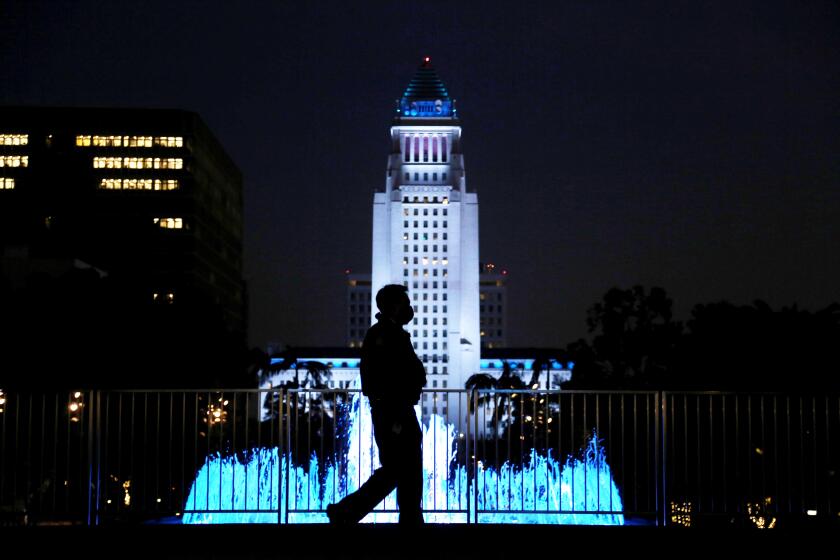Election Fraud Trial Goes to Jury
- Share via
SANTA ANA — Jurors ended their first day of deliberations Tuesday without reaching a verdict in the trial of GOP congressional aide Rhonda Carmony, who is accused of violating state election laws while recruiting a decoy Democrat to splinter the vote in a 1995 state Assembly race.
Carmony, 27, is charged with three felonies for her alleged role in helping Democrat Laurie Campbell falsify nomination papers to dilute the Democratic vote and ensure that a loyal Republican would replace Orange County Assemblywoman Doris Allen.
During the trial’s closing arguments, the prosecution for the first time conceded that Assembly Minority Leader Curt Pringle’s chief of staff, Jeff Flint, may well have been the “maestro” of the GOP scheme to fool Democratic voters.
But Assistant Dist. Atty. Brent Romney told jurors that Flint’s involvement doesn’t really matter.
“He knows about it. Does that mean that he doesn’t have somebody helping him?” Romney said. “Assume it is true that he is the ringleader, the person that put it all together. Does that mean Rhonda Carmony is not involved? Of course not.”
Prosecuting and defense attorneys wrapped up closing arguments Tuesday morning and the Orange County Superior Court jury began deliberating after lunch.
Carmony is campaign director for Rep. Dana Rohrabacher (R-Huntington Beach), as well as his fiancee.
Allen’s Assembly seat was open in 1995 after she was recalled by voters in her Cypress district. In the election that is at the heart of the Carmony trial, she was replaced by Rohrabacher protege Assemblyman Scott Baugh (R-Huntington Beach), who later cast the deciding vote to elect Pringle speaker of the Assembly.
Campbell, the decoy Democrat, was removed from the ballot by a Sacramento judge in 1995 and after the election it was revealed that she had been a close friend of Baugh for 10 years. Indictments of Baugh and Carmony followed in 1996, and testimony before two Orange County grand juries showed that an elite GOP political action committee run by philanthropist Howard Ahmanson applied pressure on GOP aides and legislators to place a phony Democrat on the ballot.
The affair rocked Republican leadership circles in 1995 and 1996.
Three aides to Baugh and Pringle pleaded guilty last year to falsely making a nomination paper and for failing to sign petitions they circulated for Campbell. They testified against Carmony in the trial, all saying she recruited them to gather signatures for Campbell.
The three aides testified that they and Carmony met with Campbell in the parking lot outside the Orange County registrar of voters office moments before the candidate filing deadline. Once there, Campbell signed the petitions the GOP aides circulated.
It is not illegal to place a decoy candidate on the ballot. Prosecutors, however, allege that Campbell illegally signed the papers to conceal that GOP aides had actually gathered her signatures.
Carmony’s defense attorney, Creighton Laz, repeatedly pointed the finger at Flint, describing as “untrustworthy” the testimony from two GOP aides who worked for Flint. Instead, Laz insisted that two Flint underlings lied to protect Flint and ultimately Pringle. The aides testified, however, that Flint knew nothing of their efforts.
Laz conceded that Carmony played a role in recruiting Campbell but did not take part in the illegal activities despite sitting in the car while Campbell signed the petitions.
In his closing, Romney ridiculed that idea. “By the defense theory, she just happened to show up there,” he said. “And she just happened to climb into the car of a woman she barely knew if at all. . . . You see how ridiculous that is.”
Romney called the crime “very serious” though some GOP leaders in Orange County, including Rohrabacher, have criticized Dist. Atty. Michael R. Capizzi for pressing the case.
“Society has to draw the line when people violate the criminal statutes of our state for the purpose of concealing the truth from the voters in an attempt to get their candidate elected,” Romney said during his closing argument. “When a very few number of individuals cross that line and commit criminal conduct, this state has to draw that line and say ‘No, you cannot go below that line.’ ”
More to Read
Sign up for Essential California
The most important California stories and recommendations in your inbox every morning.
You may occasionally receive promotional content from the Los Angeles Times.










